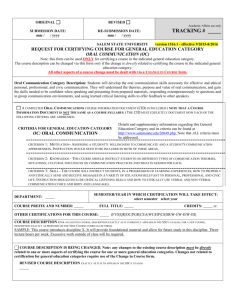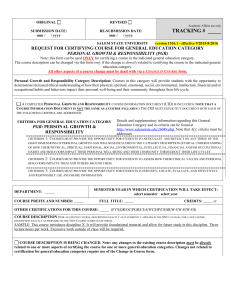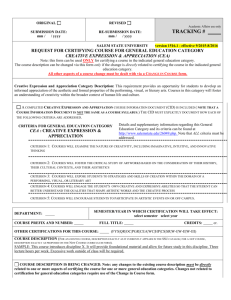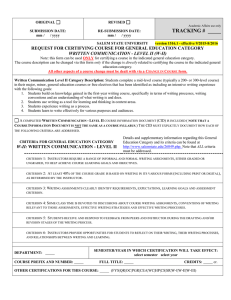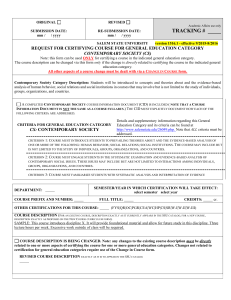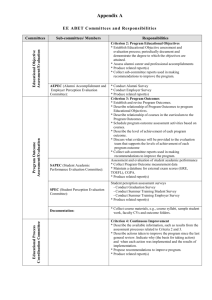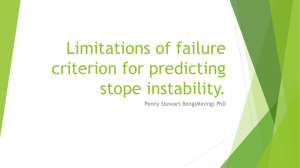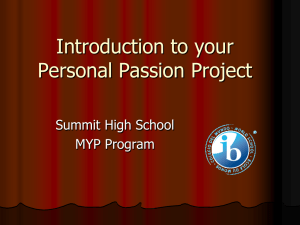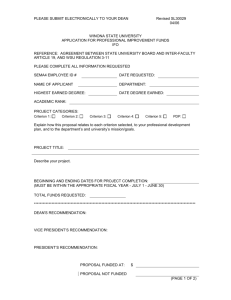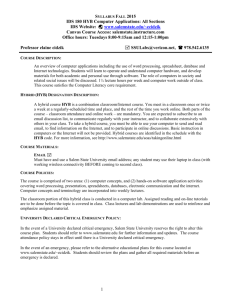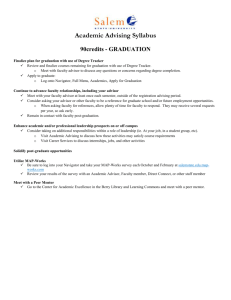CATALOG EFFECTIVE DATE: earliest possible
advertisement
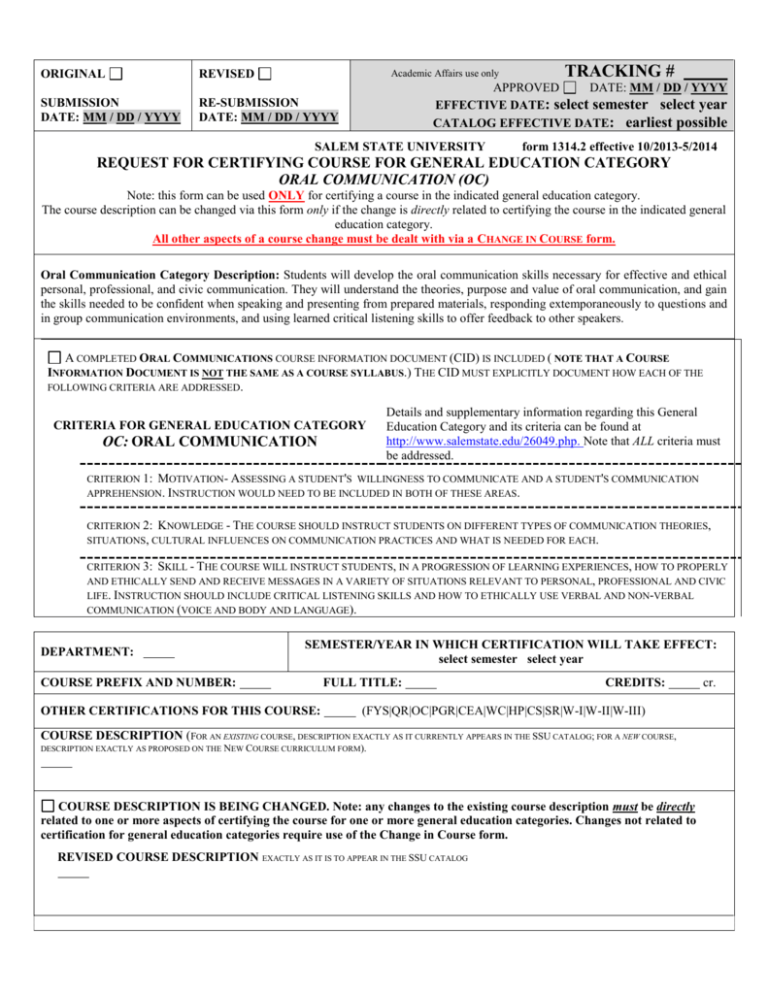
ORIGINAL
SUBMISSION
DATE: MM / DD / YYYY
REVISED
Academic Affairs use only
TRACKING #
APPROVED
DATE: MM / DD / YYYY
EFFECTIVE DATE: select semester select year
CATALOG EFFECTIVE DATE: earliest possible
RE-SUBMISSION
DATE: MM / DD / YYYY
SALEM STATE UNIVERSITY
form 1314.2 effective 10/2013-5/2014
REQUEST FOR CERTIFYING COURSE FOR GENERAL EDUCATION CATEGORY
ORAL COMMUNICATION (OC)
Note: this form can be used ONLY for certifying a course in the indicated general education category.
The course description can be changed via this form only if the change is directly related to certifying the course in the indicated general
education category.
All other aspects of a course change must be dealt with via a CHANGE IN COURSE form.
Oral Communication Category Description: Students will develop the oral communication skills necessary for effective and ethical
personal, professional, and civic communication. They will understand the theories, purpose and value of oral communication, and gain
the skills needed to be confident when speaking and presenting from prepared materials, responding extemporaneously to questions and
in group communication environments, and using learned critical listening skills to offer feedback to other speakers.
A COMPLETED ORAL COMMUNICATIONS COURSE INFORMATION DOCUMENT (CID) IS INCLUDED ( NOTE THAT A COURSE
INFORMATION DOCUMENT IS NOT THE SAME AS A COURSE SYLLABUS.) THE CID MUST EXPLICITLY DOCUMENT HOW EACH OF THE
FOLLOWING CRITERIA ARE ADDRESSED.
CRITERIA FOR GENERAL EDUCATION CATEGORY
OC: ORAL COMMUNICATION
Details and supplementary information regarding this General
Education Category and its criteria can be found at
http://www.salemstate.edu/26049.php. Note that ALL criteria must
be addressed.
CRITERION 1: MOTIVATION- ASSESSING A STUDENT'S WILLINGNESS TO COMMUNICATE AND A STUDENT'S COMMUNICATION
APPREHENSION. INSTRUCTION WOULD NEED TO BE INCLUDED IN BOTH OF THESE AREAS.
CRITERION 2: KNOWLEDGE - THE COURSE SHOULD INSTRUCT STUDENTS ON DIFFERENT TYPES OF COMMUNICATION THEORIES,
SITUATIONS, CULTURAL INFLUENCES ON COMMUNICATION PRACTICES AND WHAT IS NEEDED FOR EACH.
CRITERION 3: SKILL - THE COURSE WILL INSTRUCT STUDENTS, IN A PROGRESSION OF LEARNING EXPERIENCES, HOW TO PROPERLY
AND ETHICALLY SEND AND RECEIVE MESSAGES IN A VARIETY OF SITUATIONS RELEVANT TO PERSONAL, PROFESSIONAL AND CIVIC
LIFE. INSTRUCTION SHOULD INCLUDE CRITICAL LISTENING SKILLS AND HOW TO ETHICALLY USE VERBAL AND NON-VERBAL
COMMUNICATION (VOICE AND BODY AND LANGUAGE).
DEPARTMENT:
SEMESTER/YEAR IN WHICH CERTIFICATION WILL TAKE EFFECT:
select semester select year
COURSE PREFIX AND NUMBER:
OTHER CERTIFICATIONS FOR THIS COURSE:
FULL TITLE:
CREDITS:
(FYS|QR|OC|PGR|CEA|WC|HP|CS|SR|W-I|W-II|W-III)
COURSE DESCRIPTION (FOR AN EXISTING COURSE, DESCRIPTION EXACTLY AS IT CURRENTLY APPEARS IN THE SSU CATALOG; FOR A NEW COURSE,
DESCRIPTION EXACTLY AS PROPOSED ON THE NEW COURSE CURRICULUM FORM).
COURSE DESCRIPTION IS BEING CHANGED. Note: any changes to the existing course description must be directly
related to one or more aspects of certifying the course for one or more general education categories. Changes not related to
certification for general education categories require use of the Change in Course form.
REVISED COURSE DESCRIPTION EXACTLY AS IT IS TO APPEAR IN THE SSU CATALOG
cr.
NOTES (NOT FOR INCLUSION IN CATALOG):
SUBMITTED BY:
(name of dept. chairperson or sponsor)
DEPARTMENT:
department name Department
department website URL
Oral Communications Course Information Document
PREFIX nnn Course Title
n cr. WC
Catalog description:
Course description. Focus on the course goals in developing the description; do not incorporate implementation details unless
they are directly related to course goals. [n lecture hours [and m hours of scheduled laboratory per week] [plus work outside of class].]
Prerequisites: list all prerequisites (delete this line if there are no prerequisites)
Course Narrative:
Provide a reasonable (two to four paragraph) narrative that goes beyond the course description in articulating the pedagogical and
disciplinary mission and scope of the course. Think of this narrative as a means of connecting the dots between the course description
and course goals and outcomes.
Your narrative must include a separate description of how the criteria for certifying the course for the Oral Communications
general education category are addressed.
Course Goals:
(The wording of course goals may be phrased to meet disciplinary standards.)
This course will {introduce | explain | examine | …}:
G1:
G2:
G3:
general goal (not necessarily directly measureable);
general goal;
general goal; (insert additional goals as needed; try for no more than 3-5 goals)
Course Outcomes (Objectives):
(The wording of course outcomes may be phrased to meet disciplinary standards but outcomes must be assessable / measurable.)
Upon successful completion of the course, a student will be able to {demonstrate | explain | demonstrate | identify | …}:
O1:
O2:
O3:
specific (measurable!) objective (stated as something that the student did during the course);
specific (measurable!) objective;
specific (measurable!) objective; (insert additional objectives as needed; try for no more than 4-8 objectives)
Topics:
(Note: for special topics courses, provide appropriate separate topic outlines for two different special topics.)
topic one
sub-topic
sub-sub-topic
topic two
sub-topic
sub-sub-topic
Student Experiences: Describe the various type(s) of student experiences that will be used to assess student learning vis-à-vis stated
course objectives, e.g. presentations, tests, lab reports, writing projects, discussions, performances, etc.
Student Experiences by Course Outcome (Objective) matrix:
(Eliminate or add columns and/or rows as necessary; each row represents a student experience (similar experiences should be grouped
if appropriate - this is NOT meant to be a list of every student experience); each column relates a student experience type to the
relevant course outcomes (objectives). Insert a check mark () in any cell where a given course objective is assessed via a specific
student experience.)
student outcome / experience
(e.g. presentations, tests, lab reports, writing projects,
discussions, performances, etc.)
O1
O2
O3
O4
O5
O6
ORAL COMMUNICATIONS CRITERIA AND WHERE / HOW THEY ARE ADDRESSED IN THIS COURSE
CRITERIA FOR GENERAL EDUCATION
CATEGORY OC: ORAL
COMMUNICATIONS
ORAL COMMUNICATIONS CRITERIA
DETAILS AND SUPPLEMENTARY INFORMATION REGARDING THIS GENERAL
EDUCATION CATEGORY AND ITS CRITERIA CAN BE FOUND AT
http://www.salemstate.edu/26049.php. NOTE THAT ALL CRITERIA MUST BE
ADDRESSED.
Course outcome(s) For each Oral Communications criterion, locate and identify
(objective(s)) that
CID elements aside from course outcomes, particularly
address a criteria
student experiences, which are directly related to that
(e.g. O3, O6)
criterion.
CRITERION 1: MOTIVATION- ASSESSING A
STUDENT'S WILLINGNESS TO COMMUNICATE
AND A STUDENT'S COMMUNICATION
APPREHENSION. INSTRUCTION WOULD NEED
TO BE INCLUDED IN BOTH OF THESE AREAS.
CRITERION 2: KNOWLEDGE - THE COURSE
SHOULD INSTRUCT STUDENTS ON DIFFERENT
TYPES OF COMMUNICATION THEORIES,
SITUATIONS, CULTURAL INFLUENCES ON
COMMUNICATION PRACTICES AND WHAT IS
NEEDED FOR EACH.
CRITERION 3: SKILL - THE COURSE WILL
INSTRUCT STUDENTS, IN A PROGRESSION OF
LEARNING EXPERIENCES, HOW TO PROPERLY
AND ETHICALLY SEND AND RECEIVE
MESSAGES IN A VARIETY OF SITUATIONS
RELEVANT TO PERSONAL, PROFESSIONAL AND
CIVIC LIFE. INSTRUCTION SHOULD INCLUDE
CRITICAL LISTENING SKILLS AND HOW TO
ETHICALLY USE VERBAL AND NON-VERBAL
COMMUNICATION (VOICE AND BODY AND
LANGUAGE).
Sample Bibliography: (required for new courses only) (format as appropriate for your discipline; representative resources, not
required to be exhaustive)
(Note: for special topics courses, provide representative sample bibliographies for two different special topics.)
(examples)
Booch, Grady; Rumbaugh, James; Jacobson, Ivar. The Unified Modeling Language User Guide. Second Edition. AddisonWesley, 2005.
Gamma, Erich; Helm, Richard; Johnson, Ralph; Vlissides, John. Design Patterns: Elements of Reusable Object-Oriented
Software. Addison-Wesley, 1995.
Hwang, K.; Fox, G.; Dongarra, J. Distributed and Cloud Computing: From Parallel Processing to the Internet of Things.
Morgan Kaufmann, 2012.
(General Notes: anything in red must be deleted or replaced (and changed to black). Anything in red and in parentheses (like this note)
is an advisory comment and must be deleted. Note that while additional components may be inserted if appropriate, listed components
must be included. For examples, visit http://www.salemstate.edu/26049.php.)
